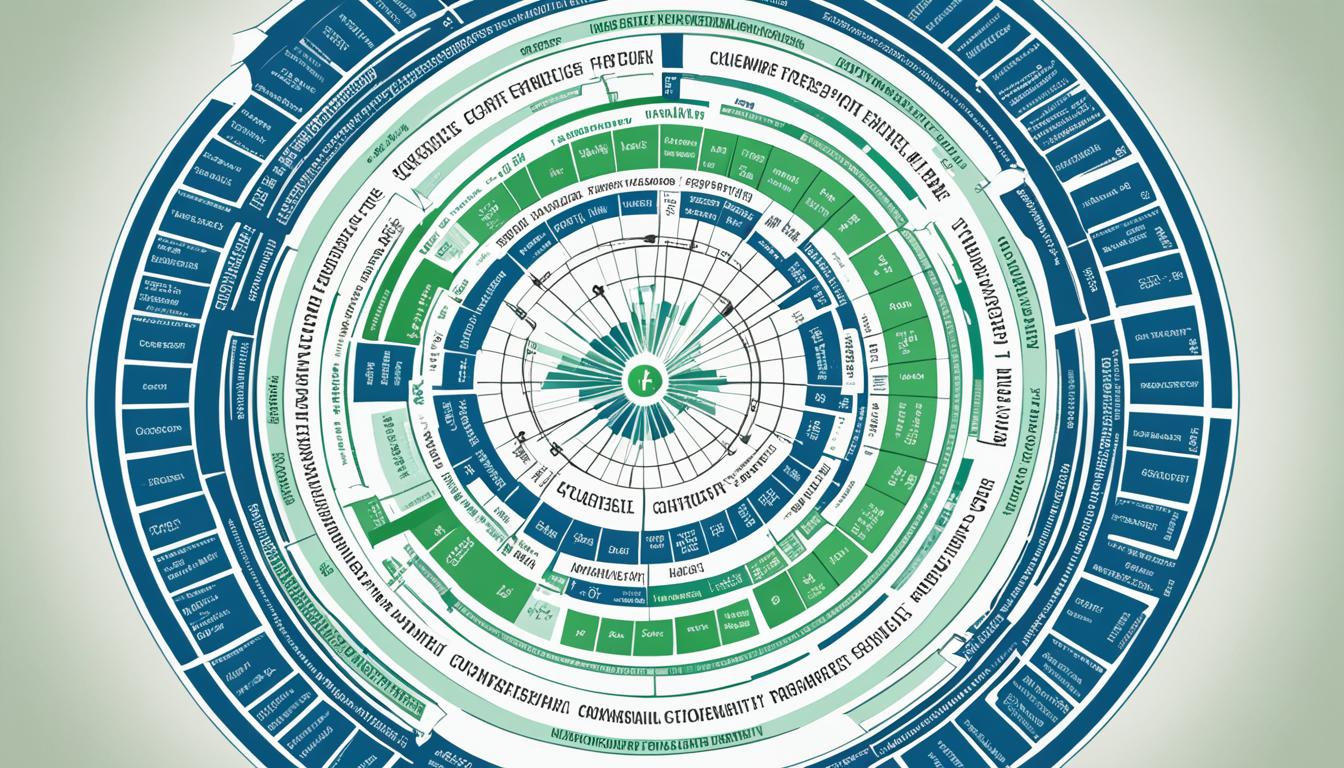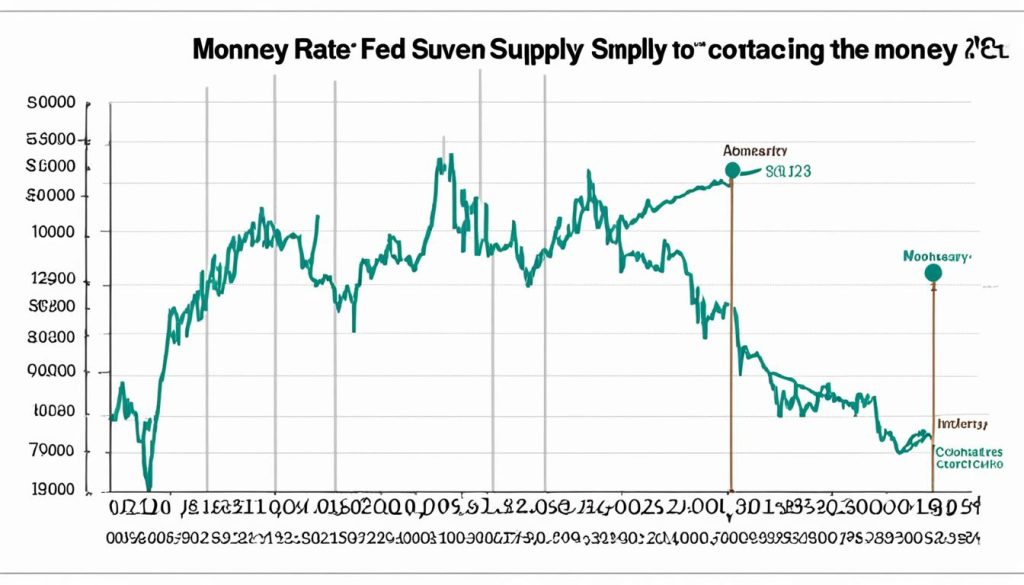The Federal Open Market Committee, known as the FOMC, is very important in the US economy. It is part of the Federal Reserve System. The FOMC makes big decisions about money and affects the economy and financial markets.
This committee has twelve members. They include seven from the Board of Governors and five Reserve Bank presidents. They meet often to talk about the economy and make important choices. They use the federal funds rate to help control inflation and create jobs.
Key Takeaways
- The FOMC is key in setting US monetary policy.
- It’s a vital part of the Federal Reserve System.
- It manages open market operations and affects the federal funds rate.
- The FOMC’s choices impact financial markets and the economy.
- The committee has twelve members, including Board of Governors and Reserve Bank presidents.
The Federal Open Market Committee: An Overview
The Federal Open Market Committee (FOMC) is key to the U.S. economy. It’s part of the federal reserve system and sets the direction of monetary policy. This affects economic growth by balancing job creation, inflation, and financial stability.
The Structure of the FOMC
The FOMC has twelve members. This includes seven from the Board of Governors and five Federal Reserve Bank presidents. The Federal Reserve Bank of New York always has a seat. The other presidents change every few years. This setup makes sure different parts of the country’s economy are heard.
| Position | No. of Members | Responsibilities |
|---|---|---|
| Board of Governors | 7 | Formulate monetary policy objectives and supervise Federal Reserve Banks. |
| Federal Reserve Bank Presidents | 5 (rotating) | Provide regional economic insights to inform policy decisions. |
The Mandate and Goals
Congress sets the FOMC’s goal to create jobs, keep prices stable, and manage long-term interest rates. They do this by adjusting interest rates and other tools. The FOMC works to grow the economy, control inflation, and strengthen the job market.
The Role of the Federal Reserve
The Federal Reserve is key to the U.S. economy. It manages the dual mandate and sets interest rates. This helps keep the economy stable and growing.
Dual Mandate: Employment and Inflation
The Federal Reserve has two main goals: to improve employment and control inflation. The Federal Open Market Committee (FOMC) works on these goals. It aims to lower unemployment and keep inflation in check.
The FOMC looks at economic data and changes its policies as needed. It keeps an eye on the job market and prices. This helps keep jobs plentiful and prices stable, helping everyone’s buying power and business success.
Regulating Interest Rates
The Federal Reserve uses interest rates to shape the economy. The FOMC sets the federal funds rate, which affects short-term interest rates. This policy is key for managing the economy, keeping it stable, and promoting growth.
Changing interest rates can have big effects. Lower rates can encourage people to borrow and invest, creating more jobs. Higher rates can slow down spending and investing, helping to fight inflation.
The Federal Reserve, led by the FOMC, plays a vital role in meeting the economy’s goals. It works towards full employment and stable inflation.
Monetary Policy and Its Importance
The Federal Open Market Committee (FOMC) is key to the financial stability of the United States. It uses monetary policy tools to guide the economy towards steady growth and stability.
Tools of Monetary Policy
It’s vital to know the tools the FOMC uses to affect the economy. These include reserve requirements, the discount rate, and open market operations.
- Reserve Requirements: This tool sets the minimum reserves banks must keep against deposits. Changing these requirements can either increase or decrease the money supply.
- Discount Rate: This is the interest rate the Federal Reserve charges banks for short-term loans. Adjusting this rate affects borrowing and lending in the economy.
- Open Market Operations: The Federal Reserve buys and sells government securities through these operations. They are crucial for controlling the money supply and reaching economic goals.
Impact on the Economy
Using these tools, the FOMC can greatly impact the economy. It can control variables like GDP growth, employment rates, and exchange rates by adjusting reserve requirements, the discount rate, and open market operations.
Lowering reserve requirements can increase the money supply, boosting economic activity. Raising the discount rate can slow down borrowing, impacting spending and investment. Open market operations help steer the economy towards balance, affecting its financial health.
These tools send waves through the economy, showing the big responsibility the FOMC has in keeping the economy stable and growing.
Decoding Economic Indicators
Economic indicators are key to understanding an economy’s health. They include GDP, CPI, and the unemployment rate. These numbers help the Federal Open Market Committee (FOMC) make decisions on monetary policy. They show trends and how well policies work.
Gross Domestic Product (GDP) shows the total value of goods and services made in a country. A growing GDP means the economy is doing well. A falling GDP suggests trouble. The FOMC looks at GDP to see how the economy is doing and what policies to use.
The Consumer Price Index (CPI) measures how prices for goods and services change over time. It’s important for inflation tracking. The FOMC uses CPI to decide on interest rates. Keeping inflation stable is key for a strong economy, and CPI helps with that.
The unemployment rate shows how many people are looking for work. High rates mean the economy might be struggling. The FOMC might ease monetary policies then. Low rates could mean it’s time for tighter policies to avoid overheating. By watching these indicators, the FOMC can support steady economic growth.
FAQ
What is the Federal Open Market Committee (FOMC)?
The FOMC is a key part of the Federal Reserve System. It oversees open market operations. It greatly affects financial markets and the economy in the United States.
What is the structure of the FOMC?
The FOMC has the Board of Governors, Presidents of the Federal Reserve Banks, and follows a rotation policy. This setup ensures diverse views and thorough decision-making in monetary policy.
What are the main objectives of the FOMC?
The FOMC aims to promote maximum employment, stable prices, and moderate long-term interest rates. These goals guide their strategies for macroeconomic stability and growth.
What is the Federal Reserve’s dual mandate?
The Federal Reserve’s dual mandate is to manage employment levels and control inflation. The FOMC targets these areas for economic stability and growth.
How does the FOMC regulate interest rates?
The FOMC controls short-term interest rates mainly through the federal funds rate target. Changing this rate can affect borrowing costs, spending, and investment.
What tools of monetary policy does the FOMC use?
The FOMC uses tools like reserve requirements, the discount rate, and open market operations for monetary policy. These tools help control the money supply and influence interest rates.
How do monetary policy decisions impact the economy?
The FOMC’s monetary policy decisions significantly affect the economy. They influence GDP growth, exchange rates, and employment levels. These decisions guide the economy towards desired goals.
What economic indicators does the FOMC consider?
The FOMC looks at economic indicators like GDP, CPI, and unemployment rates when making monetary policy decisions. These indicators help understand economic trends and are vital for decision-making.






